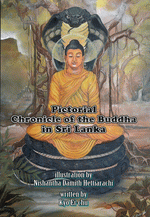 |
 |
|
 |
Pictorial Chronicle of the Buddha in Sri Lanka(スリランカの仏画伝)
Kyo Ei-chu(許永晝)Damith Hettiarachii画(ダミス・ヘッティアラッチ)
|
|
| 出版社:一般財団法人文人画研究会 |
| 出版年:2024年04月 |
| コード: 190p ISBN/ISSN 9784762995781 |
| |
|
|
<東京店在庫有り>
東京店に在庫がございます。少部数のものもございますので、ご来店の場合は直接お問合せください。
|
|
|
|
|
|
英文序
We find that ‘four asaṅkya and one hundred thousand kalpas’ ago, in other words an incredibly long time ago (asaṅkya means incalculable’ or ‘infinite’),an ascetic named Sumedha threw himself before a ‘One with Ten Powers’ named Dīpaṅkara, and thus the story of the Jātaka begins, with a scene in which Dīpaṅkara prophesies to Sumedha that ‘Many years from now, you will become a Buddha named Gotama.’
Then, in the final story of the Jātaka, no. 547, the Vessantara-Jātaka, a bodhisatta named Vessantara, who had achieved the most important of the Ten Perfections, the ‘Perfection of Dāna’(generosity, charity, almsgiving), reincarnates in the Tusita Deva World, from which bodhisattas are born before their final rebirth into the human world, and in this way the Buddha-to-be named Gotama manifests in the celestial sphere before his last rebirth, into our world.
The twenty-four Buddhas given names in the first chapter are all fully Buddhas (awakened ones), each of whom prophesy to a devotee that ‘One day you will become a Buddha.’ Each of these devotees is a previous incarnation of the Buddha-to-be Gotama. In other words, the accounts of past Buddhas take place when Gotama Siddhattha of the present world was, in previous incarnations, still a bodhisatta, a practitioner aiming for Buddhahood. Those who practice with the aim of attaining Buddhahood (to become a Buddha who saves sentient beings from suffering) are called ‘bodhisatta’, while those who already have achieved Buddhahood are called ‘Tathāgata’, literally ‘one who has thus gone’, a common epithet for a Buddha in the scriptures and a term the Buddha named Gotama commonly uses in the scriptures to refer to himself.
To understand Buddhism in Sri Lanka, where the texts of the ancient Buddhist scriptures called the Nikāya, which includes works such as Jātaka and Buddhavaṃsa, the ‘Chronicles of the Buddhas’, are still cherished today, knowing of these twenty-four past Buddhas and the ‘Completers of Dāna’ called ‘Vessantaras’ is essential. Therefore, I decided to place two contextualising chapters before the section of Buddhist paintings that follow in this book. The first of these relates the stories of the twenty-four Buddhas and their prophesies that the bodhisatta would in time become a Buddha, and the second chapter recounts the story of the Vessantara-Jātaka.
For the publication of the book, Mr. Damith Hettiarachi, a Buddhist painter whom I met in Kandy, Sri Lanka, has made Buddhist paintings which adopt traditional techniques that have been handed down in Sri Lanka. These are inspired by the graceful work of Solias Mendis (1897–1975), who is renowned for his paintings in Buddhist temples, most particularly for the magnificent murals of Kelania Rāja Mahāvihāra. Damith’s laborious work for this book was created after researching the existing murals and other remarkable works in the Sri Lankan Buddhist tradition.
For the Buddhist texts, I have adopted an easy-to-read prose style instead of direct translation of original texts in verse, as they appear in the Jātaka and Dhammapada, for example, because those texts and that style may not be familiar to modern readers.
Even for those with no particular interest in Buddhism, an opportunity to see authentic Buddhist paintings made by a contemporary Sri Lankan artist might be of interest and instruction, and this is among the reasons for bringing this book into the world. In Damith’s painstakingly-crafted work, we are sure to see the ‘heart’ that we would like to place somewhere at the centre of our daily lives.
(序文邦訳)
第一章の冒頭に出てくる「四阿僧祇十万劫」という気の遠くなるほど遥か昔、苦行者のスメーダ(漢訳では「儒童梵士」)がディーパンカラ(漢訳では「燃灯仏」)という〈十の力をもつ者〉の前にその身を投げ出したとき、「そなたはこれから遙かな年月を経た後、ゴータマという名の仏となるであろう」と授記(=仏が修行者に対して「成仏」を予告し、その保証を与えること)される処からジャータカの物語は始まる。そして、ジャータカの最終話である『ヴェッサンタラ・ジャータカ』において、〈十の完成〉のうち最も大切な〈布施の完成〉を成し遂げたボーディサッタが兜率天に転生し、いよいよ「争仏」という仏出現の争が天界で起こるのである。
本書の第一章に列記される二十四仏はすべて「ブッダ」(目覚めた者)であり、いずれも現世のゴータマ・シッダッタがまだ「菩薩」と呼ばれる成道をめざす修行者であったとき、「そなたはいずれ仏となる」と予告した仏たちなのである。
原始仏典を大切にするスリランカにおいて、今も信仰される仏伝の理解には、どうしてもこの二十四人の「過去仏」と、ヴェッサンタラという「布施の完成者」について知っておく必要があり、それゆえ敢えて仏画伝の前にこれら二章をおくことにした。
この本を刊行するに際し、スリランカのキャンディで知りあった仏画師のダミス・ヘッティアラッチ氏が、スリランカで受け継がれてきた伝統的画法により、多くの仏伝図を描いてくださった。これらの図絵は、ケラニアのマハー・ラジャ・ヴィハーラの壁画で知られるソリアス・メンディス(一八九七~一九七五)の筆致を臨摸し、さらにダンブッラに遺る古代の壁画やキャンディ周辺の寺院に現存する壁画なども研究した上で製作された、ダミス氏の労作である。
仏伝の本文は、ジャータカ(『本生経』)やダンマパダ(『法句経』)といった、現代人にはあまり馴染まない韻文様式の原典を直訳することは控え、読みやすい散文を用いた。
仏教に特に興味がない人にとっても、現代のスリランカを代表する画家の描く本格的な仏画を目にできる「千載一遇」といっても過言ではない機会を得たことだけでも、本書を世に出す意味はあるように思う。ダミス氏が丹精込めて描いた仏画の中に、私たちが日常どこかに置いてきた「心」がみえてくるはずである。(Introduction抜粋日本語訳)
目次
Contents
Introduction
Chapter Ⅰ Past Buddhas
Dipaṅkara/Koṇḍañña/Maṅgala, Sumana, Revata, and Sobhita/Anomadassi, Paduma, and Narada/Padumuttara/Sumedha and Sujata/Piyadassi, Atthadassii, Dhammadassi /Siddhattha/Tissa and Phussa/Vipassi/Sikhi and Vessabhu/Kausandha, Koṇagamana, and Kassapa/Taṇhaṅkara, Medaṅkara, and Saranaṅkara/The Merit of the Bodhisatta
Chapter Ⅱ Vessantara
Vessantara-jataka
Chapter Ⅲ Chronicle of Buddha in Paintings
1. Halahala/2. Mahamaya’s Dream/3. The Birth of Prince Siddhattha/4. Marvels at the Time of Birth/5. Mahamaya returns to Kapilavatthu/6. The Audience with the Sage Asita/7. The Naming Ceremony/8. Pajapati Gotami/9. The Royal Ploughing Ceremony/10. The Education of Prince Siddhattha/11. Demonstrating Mastery in Sporting Skills/12. The Marriage of Prince Siddhattha/13. Four visions/14. A scene of Repugnance/15. Last look at Yasodhara and Rahula/16. The Great Renunciation/17. Crossing the River Anoma/18. Severed Locks/19. Asceticism/20. Sujata’s Milk-Rice/21. The Golden Bowl/22. The Position of Victory/23. Marajaya/24. Enlightenment/25. Week One, The Throne: Dependent Origination/26. Week Two, The Gaze: Staring at the Position of Victory without Blinking/27. Week Three, The Jewelled Corridor: Yamaka-patihariya/28. Week Four, The Jewelled Hall: Paṭṭhana/29. Week Five, The Ajapala Nirodha: The Daughters of Mara/30. Week Six, The Mucalinda Nagadarana/31. Week Seven, The Rajayatana: Tapassu and Bhalluka/32. The First Sermon/33. Sixty Monks on a Sublime Mission/34. The Mahiyanganaya Hair Relic as an Object of Veneration/35. The Ordination of Sariputta and Moggallana/36. Buddha’s Visit to Kapilavatthu/37. The Buddha on His Alms Rounds/38. The Buddha Visits Yasodhara/39. The Ordination of Prince Rahula/40. Mahapajapati and the Establishment of the Bhikkhuni Order/41. The Naga Kings/42. Preaching Abhidhamma to the Mother Deva/43. Placing the Sacred Footprint/44. Devadatta Rolls a Boulder at Lord Buddha/45. The Subjugation of Naḷagiri/46. Avici/47. Tending the Sick/48. Maha Parinibbana
Appendices Mahasudassana-jataka
Chapter Ⅳ Dharmasthiti sutra(Text translated into Chinese by Xuan-zang)
Chapter Ⅴ Maha Arhat Nandhimitra nirdesa Dharmasthiti Vyakaraṇa
(Text translated into Chinese by Xuan-zang)
Anecdote about Nandhimitta,
Appendices Quote from Record of Buddhistic Kingdoms
Afterword
1. Two major faction of Maha-yana/2. Contents of Dharmasthiti Vyakaraṇa/3. History of Buddhism different from Japan/4. Sutra (Buddhist scriptures) never delivered to Japan/5. Dharmasthiti Sutra, Maha Arhat Nandhimitra nirdesa Dharmasthiti Vyakaraṇa and the Great Sixteen Arhats/6. Conclusion
List of sources
Bibliography
Painter profile
|
|
|
|
|
|





